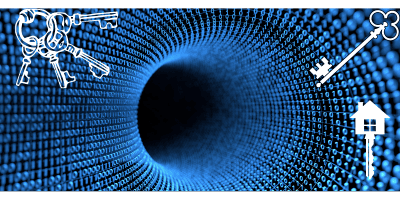Imagine a future where your home security is impenetrable, safeguarding your most valuable possessions and ensuring the privacy of your personal information. This vision is becoming a reality as the world embraces quantum computing, a revolutionary technology that holds the key to unbreakable home security encryption. By harnessing the power of quantum mechanics, this cutting-edge innovation has the potential to reshape the landscape of home security, offering unprecedented levels of protection against cyber threats. In this article, we will explore the incredible potential of quantum computing and its implications for the future of home security encryption. So, get ready to unlock the secrets of the quantum realm and discover a safer future for your home.
The Current State of Home Security Encryption
Introduction to Home Security Encryption
Home security has become an increasingly important topic in today’s digital age. With the rise of connected devices and the Internet of Things (IoT), ensuring the security and privacy of our homes has become a top priority. One of the key components of home security is encryption, which is used to protect sensitive information from unauthorized access. Encryption algorithms play a crucial role in safeguarding our data and preventing malicious attacks. In this article, we will explore the current state of home security encryption, the strengths and weaknesses of existing algorithms, and the rising threats in the digital age.
Existing Encryption Algorithms
There are several encryption algorithms currently being used to secure home networks and devices. The most widely used algorithms include the Advanced Encryption Standard (AES) and the Elliptic Curve Cryptography (ECC), versions of both are currently used by the NSA. These algorithms employ complex mathematical operations to scramble and unscramble data, making it nearly impossible for unauthorized individuals to decipher the information without the correct key. While these algorithms have been effective in providing security for many years, they are now facing new challenges with the emergence of quantum computing.
Strengths and Weaknesses
The existing encryption algorithms mentioned above have proven to be reliable and secure, providing effective protection against most cyber threats. AES, for example, is currently the gold standard for symmetric encryption and is widely used in various industries. Its strength lies in its efficiency and ability to encrypt and decrypt data quickly. However, these algorithms are not flawless and do have some weaknesses. The weaknesses of these algorithms arise from their vulnerability to attacks using quantum computers, which brings us to the next section.
Rising Threats in the Digital Age
With the advancement of technology, the rise of quantum computing poses a significant threat to the current state of home security encryption. Quantum computers have the potential to break the encryption algorithms that have been used for decades. Unlike classical computers, which use bits to represent data as either 0 or 1, quantum computers leverage the principles of quantum mechanics to use quantum bits, or qubits, which can represent 0, 1, or both simultaneously. This introduces a new level of computational power and threatens the security of traditional encryption algorithms. Understanding quantum computing is vital in order to comprehend the potential implications for home security encryption.
Understanding Quantum Computing
Introduction to Quantum Computing
Quantum computing is a revolutionary field that utilizes the principles of quantum mechanics to perform complex calculations with astonishing speed and efficiency. Unlike classical computers, which rely on bits to process information, quantum computers use qubits that can exist in multiple states simultaneously. This unique property, known as superposition, allows quantum computers to process vast amounts of information simultaneously and potentially solve complex problems exponentially faster than classical computers.
Quantum Principles and Properties
To understand quantum computing, it is essential to grasp some basic principles and properties of quantum mechanics. Superposition, as mentioned earlier, allows qubits to exist in multiple states simultaneously. This enables quantum computers to perform calculations on all possible combinations of inputs simultaneously, exponentially increasing their computational power. Another key property is entanglement, which involves the interconnection of qubits in such a way that the state of one qubit is dependent on the state of another. This property can be harnessed for secure communication and encryption.
Quantum Bits (Qubits)
Quantum bits, or qubits, are the fundamental building blocks of quantum computing. Unlike classical bits, which can only be in a state of 0 or 1, qubits can exist in a superposition of both states simultaneously. Superposition allows qubits to represent multiple classical bits of information at the same time. This unique property is what gives quantum computers their immense computational power. However, qubits are also inherently fragile and susceptible to errors caused by environmental factors, necessitating the use of error correction techniques to maintain the integrity of quantum computations.
Quantum Superposition and Entanglement
Superposition and entanglement are two key principles in quantum computing that are essential for understanding the potential implications they have on home security encryption. Superposition allows quantum computers to perform calculations on all possible combinations of inputs simultaneously, providing exponential computational power. Entanglement, on the other hand, enables the interconnection of qubits, allowing the state of one qubit to impact the state of another, regardless of the distance between them. This property can be leveraged for secure communication and encryption protocols, as we will explore in later sections.
The Potential Implications for Home Security Encryption
Quantum Computing’s Impact on Current Encryption
The development of quantum computing poses a significant threat to the current state of home security encryption. Traditional encryption algorithms, such as AES and ECC, rely on mathematical problems that are computationally intensive to solve using classical computers. However, quantum computers can exploit Shor’s algorithm to solve the integer factorization problem, possibly rendering current standards somewhat vulnerable. Furthermore, Grover’s algorithm could be used to break symmetric encryption algorithms like AES by reducing the key search space exponentially. The impact of quantum computing on current encryption necessitates the exploration of quantum-safe algorithms.
Breaking Traditional Encryption Algorithms
The security of traditional encryption algorithms is based on the assumption that solving certain mathematical problems, such as prime factorization or computing discrete logarithms, is computationally infeasible. However, quantum computers have the potential to solve these problems much faster than classical computers due to their unique computational power. Shor’s algorithm, for example, can factor large numbers into their prime components efficiently, making RSA (a 3rd encryption we haven’t discussed because of its outdated use case) susceptible to attacks. As quantum computers continue to advance, it becomes imperative to explore and develop encryption algorithms that are resistant to quantum computing threats.
Quantum-Safe Algorithms
The need for encryption algorithms that can withstand quantum computing threats has led to the development of quantum-safe algorithms, also known as post-quantum or quantum-resistant cryptography. These algorithms are specifically designed to address the vulnerabilities posed by quantum computers. Examples of quantum-safe algorithms include lattice-based cryptography, code-based cryptography, and multivariate cryptography. These algorithms are designed to provide security against attacks from both classical and quantum computers, ensuring the long-term resilience of home security encryption.
Post-Quantum Security Measures
In addition to employing quantum-safe algorithms, there are other security measures that can be implemented to mitigate the impact of quantum computing on home security encryption. One such measure is increased key sizes, which can help maintain security against brute-force attacks. As quantum computers can efficiently break symmetric encryption by reducing the key search space, increasing key sizes can make brute-force attacks computationally infeasible, even for quantum computers. Another technique is the use of quantum-resistant digital signatures, which can provide secure authentication and ensure the integrity of digital communication.
Exploring Quantum Key Distribution
Introduction to Quantum Key Distribution (QKD)

Quantum Key Distribution (QKD) is a secure method of distributing encryption keys between two parties using the principles of quantum mechanics. Unlike traditional key distribution methods, which are susceptible to intercepts and eavesdropping, QKD utilizes the properties of quantum entanglement and superposition to establish a secure communication channel and generate encryption keys. QKD offers a fundamentally secure method for distributing keys and can play a crucial role in the future of home security encryption.
Quantum Entanglement for Secure Communication
One of the key features of QKD is the use of quantum entanglement for secure communication. Through entanglement, the state of one qubit becomes directly linked to the state of another, regardless of the distance between them. This property allows for the detection of any attempt to intercept or eavesdrop on the communication channel. Any external observation or measurement of the entangled qubits will cause a disturbance that can be detected, ensuring the security and integrity of the communication.
Quantum Key Generation and Distribution
QKD utilizes the principles of quantum mechanics to generate and distribute encryption keys securely. During the key distribution process, Mickey (the sender) and Donald (the receiver) exchange qubits that are entangled in a specific way. By performing measurements on their respective qubits and exchanging the measurement outcomes over a classical channel, they can establish a shared secret key. The beauty of QKD lies in the fact that any attempt to eavesdrop on the communication will inevitably disturb the entangled qubits, alerting Mickey and Donald to the presence of an intruder.
QKD Advantages and Challenges
Quantum Key Distribution offers several advantages over traditional key distribution methods. One of the key advantages is the provable security it provides, based on the laws of quantum mechanics. Unlike computational security, which relies on the assumption that certain mathematical problems are computationally difficult, provable security guarantees that any attempt to intercept the communication will be detected. However, there are also challenges to the widespread adoption of QKD, including the limited range of qubit transmission, the requirement for dedicated infrastructure, and the high implementation costs.

Implementing Post-Quantum Cryptography
Transitioning to Post-Quantum Cryptography
The transition from traditional encryption algorithms to post-quantum cryptography is a complex process that requires careful planning and consideration. As quantum computing continues to advance, the urgency to adopt quantum-safe algorithms becomes increasingly apparent. However, implementing post-quantum cryptography is not as simple as replacing existing algorithms with quantum-safe alternatives. It requires an understanding of the specific needs and requirements of each system and the integration of new security protocols seamlessly.
Candidate Cryptographic Algorithms
Various cryptographic algorithms have been proposed as potential candidates for post-quantum cryptography. These algorithms are designed to withstand attacks from both classical and quantum computers, ensuring the long-term security of home security encryption. Lattice-based cryptography, for example, utilizes the mathematical properties of lattices to provide secure encryption. Code-based cryptography, on the other hand, relies on the problems related to error-correcting codes. Other candidates include multivariate cryptography and hash-based cryptography. Evaluating and selecting the most suitable algorithm for each specific use case is crucial in the implementation of post-quantum cryptography.
Efficiency and Performance Considerations
One of the challenges in implementing post-quantum cryptography is the trade-off between security and efficiency. Many quantum-safe algorithms are computationally more demanding compared to their classical counterparts. This can result in increased computational requirements, longer processing times, and higher resource consumption. Balancing security with usability and performance is essential to ensure practical and efficient deployment of post-quantum cryptography in home security systems. Ongoing research and advancements in hardware acceleration can help address these challenges and improve the efficiency of quantum-safe algorithms.
Interoperability Challenges
Another consideration in implementing post-quantum cryptography is the interoperability between different systems and devices. In a connected world, where various devices and networks communicate with each other, it is crucial to ensure compatibility and seamless integration across different platforms. The transition to post-quantum cryptography requires not only the adoption of new algorithms but also the development of standardized protocols that can facilitate interoperability. Collaboration among industry stakeholders, researchers, and policymakers is necessary to establish a unified approach to post-quantum cryptography and address the interoperability challenges.
Quantum Key Exchange Protocols
Key Exchange in the Quantum Realm
Key exchange protocols play a vital role in secure communication and encryption. In the quantum realm, where the principles of quantum mechanics are leveraged, key exchange protocols take advantage of the unique properties of qubits to establish secure communication channels. These protocols ensure that encryption keys are securely shared between communicating parties, protecting the confidentiality and integrity of the information being transmitted.
BB84 Protocol
The BB84 protocol is one of the first and most well-known quantum key exchange protocols. It was proposed by physicists Charles Bennett and Gilles Brassard in 1984. The BB84 protocol uses two orthogonal bases, such as vertical and horizontal polarization of photons, to encode information. The sender randomly chooses one of the two bases for each qubit and sends the encoded qubits to the receiver. Upon receiving the qubits, the receiver randomly chooses a basis for each qubit and measures it. The sender and receiver then publicly disclose the bases they used for each transmission and keep the bits for which they used the same basis to generate the encryption key.
E91 Protocol
The E91 protocol, also known as the entanglement-based protocol, is another prominent quantum key exchange protocol. Proposed by physicists Artur Ekert in 1991, the E91 protocol relies on entangled qubit pairs to establish a secure key exchange. The sender and receiver each hold one qubit from an entangled pair and measure their respective qubits using one of several measurement bases. By publicly comparing the results of their measurements, they can extract a secure encryption key. The E91 protocol is particularly interesting as it provides a method for secure key exchange without the need for a pre-shared secret key.
Quantum Key Distribution and Management
Quantum key distribution and management are critical components of home security encryption. The secure distribution of encryption keys between communicating parties ensures that the information exchanged remains confidential and secure. Quantum key distribution protocols, such as BB84 and E91, play a vital role in establishing secure channels and generating encryption keys. Additionally, efficient key management systems are necessary to handle the generation, storage, and revocation of encryption keys. Advances in quantum technology and the implementation of robust key exchange protocols are paving the way for enhanced quantum-secure home security systems.

Quantum-Safe Encryption for IoT Devices
Internet of Things (IoT) Security Challenges
The proliferation of Internet of Things (IoT) devices has transformed the way we interact with our homes and has offered numerous benefits. However, it has also introduced new security challenges. IoT devices are often interconnected and collect sensitive user data, making them attractive targets for attackers. The distributed nature of IoT systems, coupled with resource-constrained devices, poses unique security risks. Ensuring the security and privacy of IoT devices is crucial in maintaining the integrity of home security systems, necessitating the possible adoption of quantum-safe encryption algorithms.
Quantum Threats to IoT Devices
Quantum computing poses a significant threat to the security of IoT devices. As quantum computers advance, they can potentially break the encryption algorithms utilized by IoT devices, compromising the confidentiality and integrity of the data they collect and transmit. Furthermore, the interconnected nature of IoT devices implies that the compromise of a single device can have ripple effects on the entire system. Protecting IoT devices from quantum threats requires the adoption of quantum-safe encryption protocols and the implementation of robust security measures.
Secure Quantum-Safe Protocols
Secure quantum-safe protocols are essential for protecting IoT devices from quantum threats and ensuring the privacy and integrity of the data they handle. Quantum key distribution protocols, such as BB84 and E91, can be utilized to establish secure encryption keys between IoT devices and their corresponding gateways or controllers. These keys can then be used to encrypt and decrypt data transmitted between devices, protecting against unauthorized access. Additionally, the use of quantum-safe encryption algorithms, such as lattice-based cryptography or code-based cryptography, can provide long-term security for IoT devices against the threats posed by quantum computing.
Applications in Smart Home Security
The integration of quantum-safe encryption into smart home security systems offers numerous benefits. Quantum key distribution protocols can ensure secure communication between various smart devices, such as security cameras, alarms, and sensors. This ensures that the transmitted information remains confidential and authentic, protecting against unauthorized access or tampering. Furthermore, quantum-safe encryption algorithms can provide long-term security for sensitive user data stored on smart home devices or transmitted to external servers. Adopting quantum-safe encryption in smart home security systems is crucial in proactively addressing the emerging threats posed by quantum computing.
The Role of AI in Quantum Home Security
AI-Powered Threat Detection and Prevention
Artificial Intelligence (AI) plays a vital role in home security by enhancing threat detection and prevention capabilities. AI-powered systems can analyze vast amounts of data from various sensors and devices, enabling the identification of potential security threats in real-time. By leveraging machine learning algorithms, AI can continuously learn and adapt to new threats, improving the overall security of home networks. As the quantum era approaches, AI can play an even more significant role in mitigating the risks and challenges posed by quantum computing to home security encryption.
Machine Learning for Quantum Algorithms
Machine learning techniques can be applied to quantum algorithms to optimize their performance and efficiency. By training machine learning models on quantum data, researchers can identify patterns and correlations that can help improve the execution of quantum algorithms. This can lead to advancements in quantum cryptography, making it more accessible and efficient for home security applications. Machine learning can also aid in the detection of quantum threats, helping identify potential vulnerabilities in quantum systems and developing countermeasures against attacks.

Pattern Recognition and Anomaly Detection
AI-powered systems excel in pattern recognition and anomaly detection, which are crucial in home security encryption. By analyzing network traffic and device behavior, AI can identify patterns of normal operation and detect any suspicious or abnormal activities. This enables proactive measures to be taken, such as flagging potential security breaches or shutting down unauthorized access attempts. As quantum threats evolve, AI can adapt and learn new patterns to identify potential attacks, bolstering the defense against quantum-based security breaches.
Quantum Computing in AI Training
Quantum computing can also play a role in advancing AI training algorithms. Quantum machine learning algorithms leverage the computational power of quantum computers to enhance the training process, enabling faster and more efficient model training. Quantum-inspired algorithms, such as the Quantum Boltzmann Machine, can utilize quantum principles to optimize the search for optimal solutions in training complex AI models. The synergy between quantum computing and AI has the potential to drive innovation in home security encryption and create more robust and intelligent defense systems.

Standardization and Adoption Challenges
Developing Industry Standards
Standardization is a crucial step in the widespread adoption of quantum-safe encryption in home security systems. The development of standardized protocols, algorithms, and frameworks ensures interoperability and enables seamless integration across different devices and networks. Collaborative efforts among industry stakeholders, researchers, and policymakers are essential in establishing a unified approach to quantum-safe encryption. The creation of industry standards paves the way for a secure and scalable future in home security, where the confidentiality and integrity of sensitive information are upheld.
Policy and Regulatory Considerations
The adoption of quantum-safe encryption in home security systems requires careful consideration of policy and regulatory frameworks. As quantum computing poses new challenges and threats, policymakers and regulatory bodies need to stay informed and updated to address these emerging issues effectively. The development of regulations and policies that encourage the implementation of post-quantum security measures is vital in ensuring a secure and resilient home security ecosystem. Collaboration between government agencies, industry leaders, and cybersecurity experts is necessary to establish robust policies and regulatory frameworks that promote the adoption of quantum-safe encryption.
Educating and Training Professionals
With the rapid advancements in quantum computing and encryption, it is crucial to educate and train professionals in the field of quantum-safe cryptography. The adoption of quantum-safe encryption in home security systems requires skilled experts who can design, implement, and maintain these secure systems. Investing in education and training programs that focus on quantum computing and quantum-safe encryption will ensure the availability of a competent workforce capable of addressing the challenges and opportunities presented by the quantum era in home security.
Cost and Infrastructure Requirements
The implementation of quantum-safe encryption in home security systems may come with certain cost and infrastructure requirements. Quantum computing and quantum-safe algorithms often require specialized hardware and infrastructure, which may add to the overall expenses. Addressing these cost considerations and ensuring the availability of affordable solutions is crucial in the widespread adoption of quantum-safe encryption. Additionally, the integration of quantum-safe encryption algorithms may require updates to existing home security systems, making it essential to consider the scalability and compatibility of these systems with new encryption standards.
Conclusion: Preparing for the Quantum Era
The Need for Quantum-Ready Security Solutions
As the era of quantum computing approaches, the need for quantum-ready security solutions becomes increasingly apparent. Home security encryption is no exception. The rising threats posed by quantum computers to existing encryption algorithms require proactive measures to ensure the security and privacy of our homes. Embracing quantum computing and quantum-safe encryption is crucial in preparing for the quantum era and establishing a secure future.
Timeline for Quantum Computing Implementation
While quantum computers are still in the early stages of development, their potential to break classical encryption algorithms cannot be overlooked. It is difficult to predict an exact timeline for when quantum computing will reach the stage where it can pose a serious threat to home security encryption. However, as advancements continue and quantum computers become more powerful, it is essential to stay vigilant and start implementing quantum-safe encryption sooner rather than later.
Collaboration for a Secure Future
Addressing the challenges and opportunities presented by the quantum era requires collaboration across various stakeholders. Industry leaders, researchers, policymakers, and cybersecurity experts need to work together to develop standardized protocols, algorithms, and frameworks for quantum-safe encryption in home security systems. By fostering collaboration and sharing knowledge and resources, we can collectively build a secure future that can withstand the threats posed by quantum computing.
Balancing the Benefits and Risks
While the rise of quantum computing presents new risks and challenges, it also brings forth immense opportunities. Quantum computing has the potential to revolutionize various fields, including home security encryption. By embracing quantum technology and leveraging its unique properties, we can develop more secure and robust encryption algorithms that can protect our homes and ensure the privacy of our sensitive information. Balancing the benefits and risks of quantum computing is crucial in creating a secure future for home security.
Editor’s Note:

As the only editor for the Power Pros Project, I would like to personally thank Power Pro team member Brian J. for giving me a headache. Most of the articles I edit from team members require about a half hour of my time to research (trust but verify) and add appropriate images and/or videos. This particular article took several hours and a dose of Excedrin to get thru. Brian, you know I love you like a brother, but man, you need to go on a vacation. Mark M.
